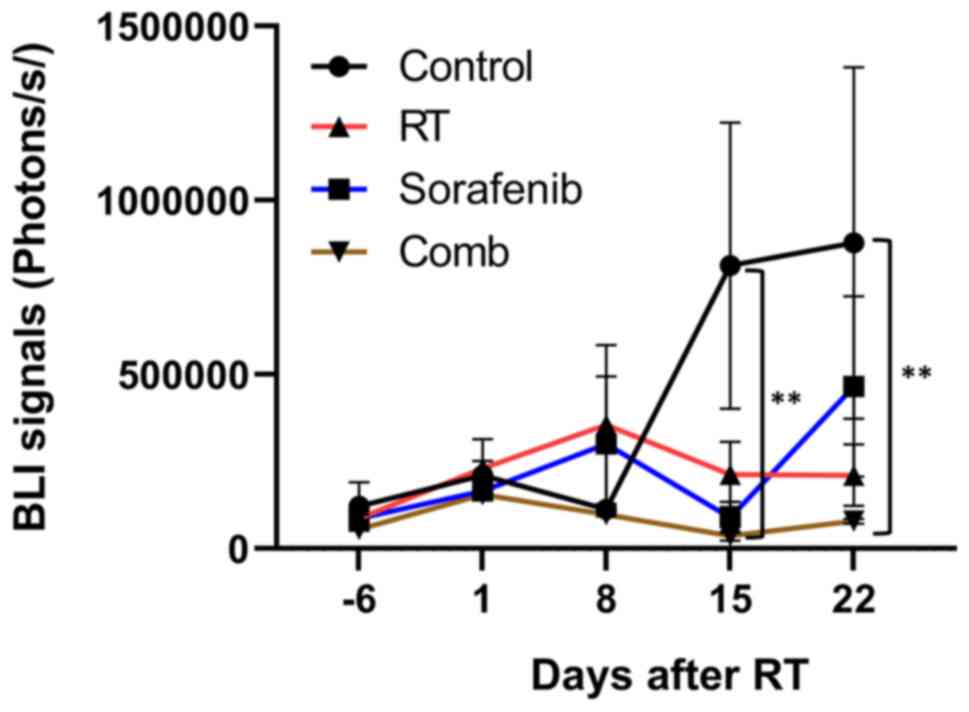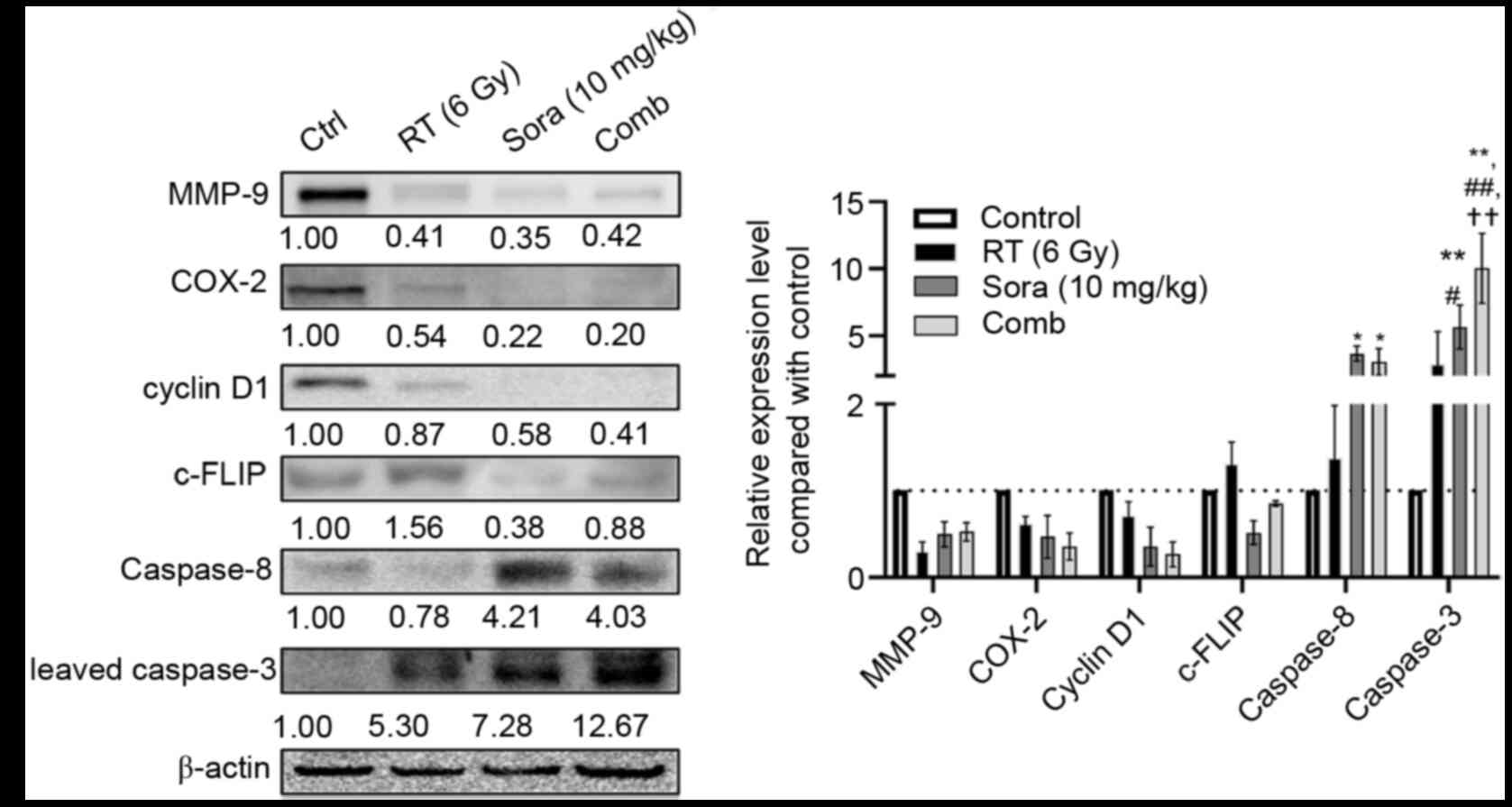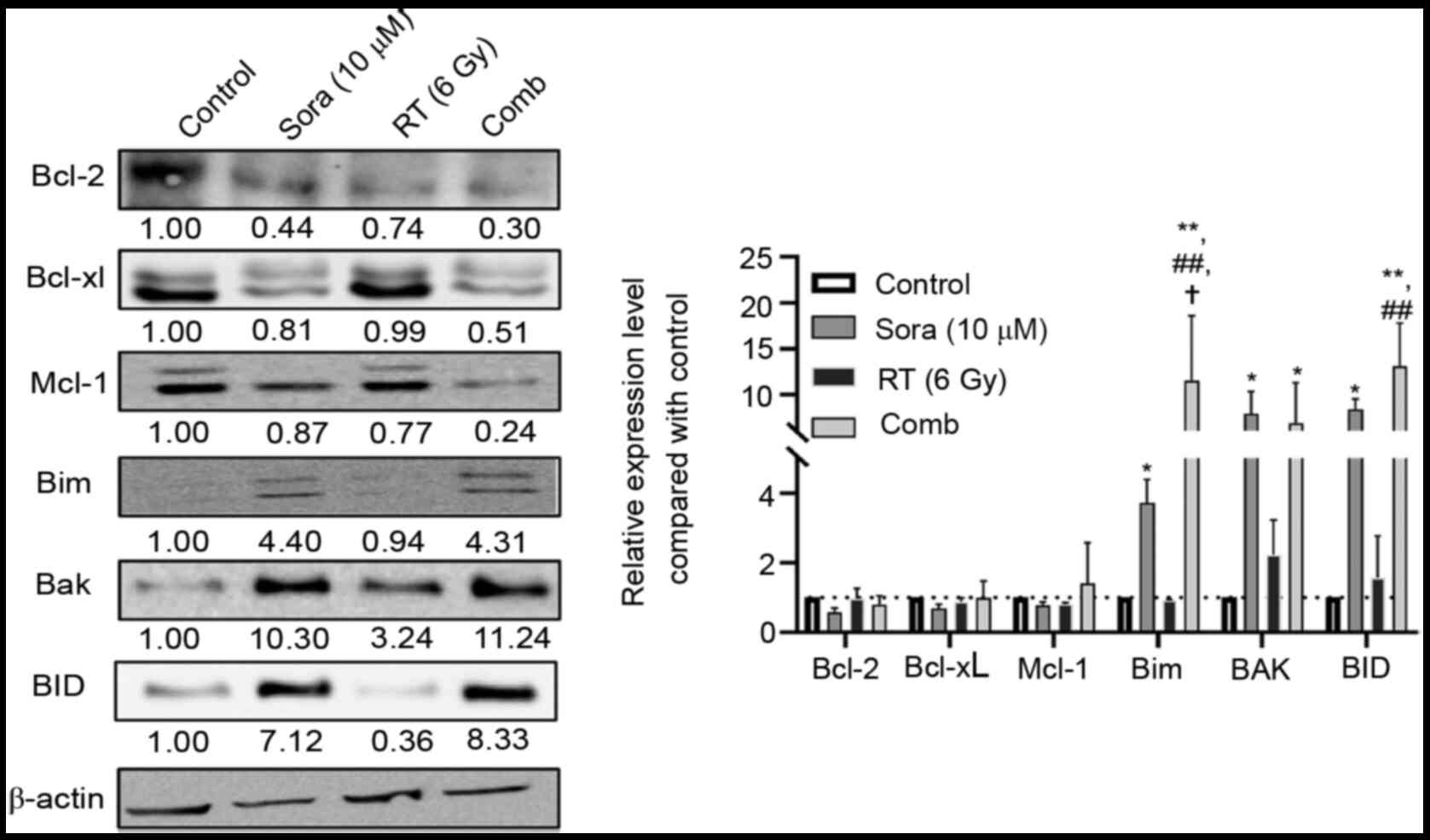A combination of sorafenib and radiotherapy reduces NF‑κB activity and growth of hepatocellular carcinoma in an orthotopic mouse model
- Authors:
- Hui-Yen Chuang
- Yeu-Sheng Tyan
- Jeng-Jong Hwang
- Kuang-Chung Shih
- Wei-Chan Lin
-
Affiliations: Department of Biomedical Imaging and Radiological Sciences, National Yang Ming Chiao Tung University, Taipei 112, Taiwan, R.O.C., Department of Medical Imaging, Chung Shan Medical University Hospital, Taichung 402, Taiwan, R.O.C., Division of Endocrinology and Metabolism, Department of Medicine, Cheng‑Hsin General Hospital, Taipei 112, Taiwan, R.O.C. - Published online on: February 26, 2021 https://doi.org/10.3892/ol.2021.12598
- Article Number: 337
-
Copyright: © Chuang et al. This is an open access article distributed under the terms of Creative Commons Attribution License.
This article is mentioned in:
Abstract
 |
 |
 |
 |
 |
 |
 |
 |
|
McGlynn KA, Petrick JL and London WT: Global epidemiology of hepatocellular carcinoma: An emphasis on demographic and regional variability. Clin Liver Dis. 19:223–238. 2015. View Article : Google Scholar : PubMed/NCBI | |
|
Golabi P, Fazel S, Otgonsuren M, Sayiner M, Locklear CT and Younossi ZM: Mortality assessment of patients with hepatocellular carcinoma according to underlying disease and treatment modalities. Medicine (Baltimore). 96:e5904. 2017. View Article : Google Scholar : PubMed/NCBI | |
|
Llovet JM, Ricci S, Mazzaferro V, Hilgard P, Gane E, Blanc JF, de Oliveira AC, Santoro A, Raoul JL, Forner A, et al: Sorafenib in advanced hepatocellular carcinoma. N Engl J Med. 359:378–390. 2008. View Article : Google Scholar : PubMed/NCBI | |
|
Chen L, Sun J and Yang X: Radiofrequency ablation-combined multimodel therapies for hepatocellular carcinoma: Current status. Cancer Lett. 370:78–84. 2016. View Article : Google Scholar : PubMed/NCBI | |
|
Chao Y, Chung YH, Han G, Yoon JH, Yang J, Wang J, Shao GL, Kim BI and Lee TY: The combination of transcatheter arterial chemoembolization and sorafenib is well tolerated and effective in Asian patients with hepatocellular carcinoma: Final results of the START trial. Int J Cancer. 136:1458–1467. 2015. View Article : Google Scholar : PubMed/NCBI | |
|
Hsieh CH, Jeng KS, Lin CC, Chen CK, Liu CY, Lin CP, Tai HC, Wang CH, Shueng PW and Chen YJ: Combination of sorafenib and intensity modulated radiotherapy for unresectable hepatocellular carcinoma. Clin Drug Investig. 29:65–71. 2009. View Article : Google Scholar : PubMed/NCBI | |
|
Cha J, Seong J, Lee IJ, Kim JW and Han KH: Feasibility of Sorafenib combined with local radiotherapy in advanced hepatocellular carcinoma. Yonsei Med J. 54:1178–1185. 2013. View Article : Google Scholar : PubMed/NCBI | |
|
Chen SW, Lin LC, Kuo YC, Liang JA, Kuo CC and Chiou JF: Phase 2 study of combined sorafenib and radiation therapy in patients with advanced hepatocellular carcinoma. Int J Radiat Oncol Biol Phys. 88:1041–1047. 2014. View Article : Google Scholar : PubMed/NCBI | |
|
Brade AM, Ng S, Brierley J, Kim J, Dinniwell R, Ringash J, Wong RR, Cho C, Knox J and Dawson LA: Phase 1 trial of sorafenib and stereotactic body radiation therapy for hepatocellular carcinoma. Int J Radiat Oncol Biol Phys. 94:580–587. 2016. View Article : Google Scholar : PubMed/NCBI | |
|
Stryker JA: Science to practice: Why is the liver a radiosensitive organ? Radiology. 242:1–2. 2007. View Article : Google Scholar : PubMed/NCBI | |
|
Kalogeridi MA, Zygogianni A, Kyrgias G, Kouvaris J, Chatziioannou S, Kelekis N and Kouloulias V: Role of radiotherapy in the management of hepatocellular carcinoma: A systematic review. World J Hepatol. 7:101–112. 2015. View Article : Google Scholar : PubMed/NCBI | |
|
Ricke J, Bulla K, Kolligs F, Peck-Radosavljevic M, Reimer P, Sangro B, Schott E, Schütte K, Verslype C, Walecki J, et al: Safety and toxicity of radioembolization plus Sorafenib in advanced hepatocellular carcinoma: Analysis of the European multicentre trial SORAMIC. Liver Int. 35:620–626. 2015. View Article : Google Scholar : PubMed/NCBI | |
|
Riaz A, Gabr A, Abouchaleh N, Ali R, Al Asadi A, Mora R, Kulik L, Desai K, Thornburg B, Mouli S, et al: Radioembolization for hepatocellular carcinoma: Statistical confirmation of improved survival in responders by landmark analyses. Hepatology. 67:873–883. 2018. View Article : Google Scholar : PubMed/NCBI | |
|
Guha C and Kavanagh BD: Hepatic radiation toxicity: Avoidance and amelioration. Semin Radiat Oncol. 21:256–263. 2011. View Article : Google Scholar : PubMed/NCBI | |
|
Seidensticker R, Seidensticker M, Damm R, Mohnike K, Schütte K, Malfertheiner P, Van Buskirk M, Pech M, Amthauer H and Ricke J: Hepatic toxicity after radioembolization of the liver using (90)Y-microspheres: Sequential lobar versus whole liver approach. Cardiovasc Intervent Radiol. 35:1109–1118. 2012. View Article : Google Scholar : PubMed/NCBI | |
|
Mahvash A, Murthy R, Odisio BC, Raghav KP, Girard L, Cheung S, Nguyen V, Ensor J, Gadani S, Elsayes KM, et al: Yttrium-90 resin microspheres as an adjunct to sorafenib in patients with unresectable hepatocellular carcinoma. J Hepatocell Carcinoma. 3:1–7. 2016.PubMed/NCBI | |
|
Ricke J, Klumpen HJ, Amthauer H, Bargellini I, Bartenstein P, de Toni EN, Gasbarrini A, Pech M, Peck-Radosavljevic M, Popovič P, et al: Impact of combined selective internal radiation therapy and sorafenib on survival in advanced hepatocellular carcinoma. J Hepatol. 71:1164–1174. 2019. View Article : Google Scholar : PubMed/NCBI | |
|
Yu W, Gu K, Yu Z, Yuan D, He M, Ma N, Lai S, Zhao J, Ren Z, Zhang X, et al: Sorafenib potentiates irradiation effect in hepatocellular carcinoma in vitro and in vivo. Cancer Lett. 329:109–117. 2013. View Article : Google Scholar : PubMed/NCBI | |
|
Hsu FT, Chang B, Chen JC, Chiang IT, Liu YC, Kwang WK and Hwang JJ: Synergistic effect of sorafenib and radiation on human oral carcinoma in vivo. Sci Rep. 5:153912015. View Article : Google Scholar : PubMed/NCBI | |
|
Chen JCH, Chuang HY, Hsu FT, Chen YC, Chien YC and Hwang JJ: Sorafenib pretreatment enhances radiotherapy through targeting MEK/ERK/NF-κB pathway in human hepatocellular carcinoma-bearing mouse model. Oncotarget. 7:85450–85463. 2016. View Article : Google Scholar : PubMed/NCBI | |
|
Wang WH, Chiang IT, Liu YC, Hsu FT, Chen HW, Chen CL, Lee YJ, Lin WJ and Hwang JJ: Simultaneous imaging of temporal changes of NF-κB activity and viable tumor cells in Huh7/NF-κB-tk-luc2/rfp tumor-bearing mice. In Vivo. 27:339–350. 2013.PubMed/NCBI | |
|
Hoesel B and Schmid JA: The complexity of NF-κB signaling in inflammation and cancer. Mol Cancer. 12:862013. View Article : Google Scholar : PubMed/NCBI | |
|
Zamora-Valdes D, Taner T and Nagorney DM: Surgical treatment of hepatocellular carcinoma. Cancer Control. 24:10732748177292582017. View Article : Google Scholar : PubMed/NCBI | |
|
Eggert T and Greten TF: Current standard and future perspectives in non-surgical therapy for hepatocellular carcinoma. Digestion. 96:1–4. 2017. View Article : Google Scholar : PubMed/NCBI | |
|
Huang A, Yang XR, Chung WY, Dennison AR and Zhou J: Targeted therapy for hepatocellular carcinoma. Signal Transduct Target Ther. 5:1462020. View Article : Google Scholar : PubMed/NCBI | |
|
Wilhelm SM, Adnane L, Newell P, Villanueva A, Llovet JM and Lynch M: Preclinical overview of sorafenib, a multikinase inhibitor that targets both Raf and VEGF and PDGF receptor tyrosine kinase signaling. Mol Cancer Ther. 7:3129–3140. 2008. View Article : Google Scholar : PubMed/NCBI | |
|
Hayabuchi N: Radiocurable tumors and non-radiocurable tumors. Japan Med Assoc J. 47:79–83. 2004. | |
|
Piao LS, Hur W, Kim TK, Hong SW, Kim SW, Choi JE, Sung PS, Song MJ, Lee BC, Hwang D and Yoon SK: CD133+ liver cancer stem cells modulate radioresistance in human hepatocellular carcinoma. Cancer Lett. 315:129–137. 2012. View Article : Google Scholar : PubMed/NCBI | |
|
Li F and Sethi G: Targeting transcription factor NF-kappaB to overcome chemoresistance and radioresistance in cancer therapy. Biochim Biophys Acta Rev Cancer. 1805:167–180. 2010. View Article : Google Scholar | |
|
Qiao Q, Sun C, Han C, Han N, Zhang M and Li G: Endoplasmic reticulum stress pathway PERK-eIF2α confers radioresistance in oropharyngeal carcinoma by activating NF-κB. Cancer Sci. 108:1421–1431. 2017. View Article : Google Scholar : PubMed/NCBI | |
|
Ren K, Li Z, Li Y, Zhang W and Han X: Sulforaphene enhances radiosensitivity of hepatocellular carcinoma through suppression of the NF-κB pathway. J Biochem Mol Toxicol. 31:e219172017. View Article : Google Scholar | |
|
Ji K, Sun X, Liu Y, Du L, Wang Y, He N, Wang J, Xu C and Liu Q: Regulation of apoptosis and radiation sensitization in lung cancer cells via the Sirt1/NF-κB/smac pathway. Cell Physiol Biochem. 48:304–316. 2018. View Article : Google Scholar : PubMed/NCBI | |
|
Smartt HJ, Elder DJ, Hicks DJ, Williams NA and Paraskeva C: Increased NF-kappaB DNA binding but not transcriptional activity during apoptosis induced by the COX-2-selective inhibitor NS-398 in colorectal carcinoma cells. Br J Cancer. 89:1358–1365. 2003. View Article : Google Scholar : PubMed/NCBI | |
|
Vanden Berghe W, Dijsselbloem N, Vermeulen L, Ndlovu MN, Boone E and Haegeman G: Attenuation of mitogen- and stress-activated protein kinase-1-driven nuclear factor-kappaB gene expression by soy isoflavones does not require estrogenic activity. Cancer Res. 66:4852–4862. 2006. View Article : Google Scholar : PubMed/NCBI | |
|
Close DM, Xu T, Sayler GS and Ripp S: In vivo bioluminescent imaging (BLI): Noninvasive visualization and interrogation of biological processes in living animals. Sensors (Basel). 11:180–206. 2011. View Article : Google Scholar : PubMed/NCBI | |
|
Kunnumakkara AB, Diagaradjane P, Anand P, Harikumar KB, Deorukhkar A, Gelovani J, Guha S, Krishnan S and Aggarwal BB: Curcumin sensitizes human colorectal cancer to capecitabine by modulation of cyclin D1, COX-2, MMP-9, VEGF and CXCR4 expression in an orthotopic mouse model. Int J Cancer. 125:2187–2197. 2009. View Article : Google Scholar : PubMed/NCBI | |
|
Bachmeier BE, Killian PH and Melchart D: The role of curcumin in prevention and management of metastatic disease. Int J Mol Sci. 19:17162018. View Article : Google Scholar | |
|
Lai ZC, Wei X, Shimizu T, Ramos E, Rohrbaugh M, Nikolaidis N, Ho LL and Li Y: Control of cell proliferation and apoptosis by mob as tumor suppressor, Mats. Cell. 120:675–685. 2005. View Article : Google Scholar : PubMed/NCBI | |
|
Safa AR: c-FLIP, a master anti-apoptotic regulator. Exp Oncol. 34:176–184. 2012.PubMed/NCBI | |
|
Stagni V, di Bari MG, Cursi S, Condò I, Cencioni MT, Testi R, Lerenthal Y, Cundari E and Barilà D: ATM kinase activity modulates Fas sensitivity through the regulation of FLIP in lymphoid cells. Blood. 111:829–837. 2008. View Article : Google Scholar : PubMed/NCBI | |
|
Ivanov VN, Zhou H, Partridge MA and Hei TK: Inhibition of ataxia telangiectasia mutated kinase activity enhances TRAIL-mediated apoptosis in human melanoma cells. Cancer Res. 69:3510–3519. 2009. View Article : Google Scholar : PubMed/NCBI | |
|
Kim TE, Hong S, Song K, Park SH and Shin YK: Sensitization of glycoengineered interferon-β1a-resistant cancer cells by cFLIP inhibition for enhanced anti-cancer therapy. Oncotarget. 8:13957–13970. 2017. View Article : Google Scholar : PubMed/NCBI | |
|
Poondla N, Chandrasekaran AP, Heese K, Kim KS and Ramakrishna S: CRISPR-mediated upregulation of DR5 and downregulation of cFLIP synergistically sensitize HeLa cells to TRAIL-mediated apoptosis. Biochem Biophys Res Commun. 512:60–65. 2019. View Article : Google Scholar : PubMed/NCBI | |
|
Maier P, Hartmann L, Wenz F and Herskind C: Cellular pathways in response to ionizing radiation and their targetability for tumor radiosensitization. Int J Mol Sci. 17:1022016. View Article : Google Scholar | |
|
McLaughlin KA, Nemeth Z, Bradley CA, Humphreys L, Stasik I, Fenning C, Majkut J, Higgins C, Crawford N, Holohan C, et al: FLIP: A targetable mediator of resistance to radiation in non-small cell lung cancer. Mol Cancer Ther. 15:2432–2441. 2016. View Article : Google Scholar : PubMed/NCBI | |
|
Ranjan K and Pathak C: FADD regulates NF-kappaB activation and promotes ubiquitination of cFLIPL to induce apoptosis. Sci Rep. 6:227872016. View Article : Google Scholar : PubMed/NCBI | |
|
Catz SD and Johnson JL: Transcriptional regulation of bcl-2 by nuclear factor kappa B and its significance in prostate cancer. Oncogene. 20:7342–7351. 2001. View Article : Google Scholar : PubMed/NCBI | |
|
Engels IH, Stepczynska A, Stroh C, Lauber K, Berg C, Schwenzer R, Wajant H, Jänicke RU, Porter AG, Belka C, et al: Caspase-8/FLICE functions as an executioner caspase in anticancer drug-induced apoptosis. Oncogene. 19:4563–4573. 2000. View Article : Google Scholar : PubMed/NCBI | |
|
Delbridge AR and Strasser A: The BCL-2 protein family, BH3-mimetics and cancer therapy. Cell Death Differ. 22:1071–1080. 2015. View Article : Google Scholar : PubMed/NCBI | |
|
Tong J, Wang P, Tan S, Chen D, Nikolovska-Coleska Z, Zou F, Yu J and Zhang L: Mcl-1 degradation is required for targeted therapeutics to eradicate colon cancer cells. Cancer Res. 77:2512–2521. 2017. View Article : Google Scholar : PubMed/NCBI | |
|
Hsu C, Lin LI, Cheng YC, Feng ZR, Shao YY, Cheng AL and Ou DL: Cyclin E1 Inhibition can overcome sorafenib resistance in hepatocellular carcinoma cells through Mcl-1 suppression. Clin Cancer Res. 22:2555–2564. 2016. View Article : Google Scholar : PubMed/NCBI | |
|
Tutusaus A, Stefanovic M, Boix L, Cucarull B, Zamora A, Blasco L, de Frutos PG, Reig M, Fernandez-Checa JC, Marí M, et al: Antiapoptotic BCL-2 proteins determine sorafenib/regorafenib resistance and BH3-mimetic efficacy in hepatocellular carcinoma. Oncotarget. 9:16701–16717. 2018. View Article : Google Scholar : PubMed/NCBI | |
|
Hikita H, Takehara T, Shimizu S, Kodama T, Shigekawa M, Iwase K, Hosui A, Miyagi T, Tatsumi T, Ishida H, et al: The Bcl-xL inhibitor, ABT-737, efficiently induces apoptosis and suppresses growth of hepatoma cells in combination with sorafenib. Hepatology. 52:1310–1321. 2010. View Article : Google Scholar : PubMed/NCBI | |
|
Ivanisenko NV, Buchbinder JH, Espe J, Richter M, Bollmann M, Hillert LK, Ivanisenko VA and Lavrik IN: Delineating the role of c-FLIP/NEMO interaction in the CD95 network via rational design of molecular probes. BMC Genomics. 20 (Suppl 3):S2932019. View Article : Google Scholar | |
|
Jiang Z and Clemens PR: Cellular caspase-8-like inhibitory protein (cFLIP) prevents inhibition of muscle cell differentiation induced by cancer cells. FASEB J. 20:2570–2572. 2006. View Article : Google Scholar : PubMed/NCBI | |
|
Guo ZL, Li JZ, Ma YY, Qian D, Zhong JY, Jin MM, Huang P, Che LY, Pan B, Wang Y, et al: Shikonin sensitizes A549 cells to TRAIL-induced apoptosis through the JNK, STAT3 and AKT pathways. BMC Cell Biol. 19:292018. View Article : Google Scholar : PubMed/NCBI | |
|
Kim S, Woo SM, Min KJ, Seo SU, Lee TJ, Kubatka P, Kim DE and Kwon TK: WP1130 enhances TRAIL-induced apoptosis through USP9X-dependent miR-708-mediated downregulation of c-FLIP. Cancers (Basel). 11:3442019. View Article : Google Scholar | |
|
Gu FM, Li QL, Gao Q, Jiang JH, Huang XY, Pan JF, Fan J and Zhou J: Sorafenib inhibits growth and metastasis of hepatocellular carcinoma by blocking STAT3. World J Gastroenterol. 17:3922–3932. 2011. View Article : Google Scholar : PubMed/NCBI | |
|
Tai WT, Cheng AL, Shiau CW, Huang HP, Huang JW, Chen PJ and Chen KF: Signal transducer and activator of transcription 3 is a major kinase-independent target of sorafenib in hepatocellular carcinoma. J Hepatol. 55:1041–1048. 2011. View Article : Google Scholar : PubMed/NCBI | |
|
Huang CY, Lin CS, Tai WT, Hsieh CY, Shiau CW, Cheng AL and Chen KF: Sorafenib enhances radiation-induced apoptosis in hepatocellular carcinoma by inhibiting STAT3. Int J Radiat Oncol Biol Phys. 86:456–462. 2013. View Article : Google Scholar : PubMed/NCBI | |
|
Chen KF, Tai WT, Liu TH, Huang HP, Lin YC, Shiau CW, Li PK, Chen PJ and Cheng AL: Sorafenib overcomes TRAIL resistance of hepatocellular carcinoma cells through the inhibition of STAT3. Clin Cancer Res. 16:5189–5199. 2010. View Article : Google Scholar : PubMed/NCBI | |
|
La Tessa C, Berger T, Kaderka R, Schardt D, Körner C, Ramm U, Licher J, Matsufuji N, Vallhagen Dahlgren C, Lomax T, et al: Out-of-field dose studies with an anthropomorphic phantom: Comparison of X-rays and particle therapy treatments. Radiother Oncol. 105 1:133–138. 2012. View Article : Google Scholar : PubMed/NCBI | |
|
Loeffler JS and Durante M: Charged particle therapy-optimization, challenges and future directions. Nat Rev Clin Oncol. 10:411–424. 2013. View Article : Google Scholar : PubMed/NCBI | |
|
Dolcet X, Llobet D, Pallares J and Matias-Guiu X: NF-κB in development and progression of human cancer. Virchows Archiv. 446:475–482. 2005. View Article : Google Scholar : PubMed/NCBI | |
|
Grivennikov SI and Karin M: Dangerous liaisons: STAT3 and NF-kappaB collaboration and crosstalk in cancer. Cytokine Growth Factor Rev. 21:11–19. 2010. View Article : Google Scholar : PubMed/NCBI | |
|
Yu H, Lee H, Herrmann A, Buettner R and Jove R: Revisiting STAT3 signalling in cancer: New and unexpected biological functions. Nat Rev Cancer. 14:736–746. 2014. View Article : Google Scholar : PubMed/NCBI |









